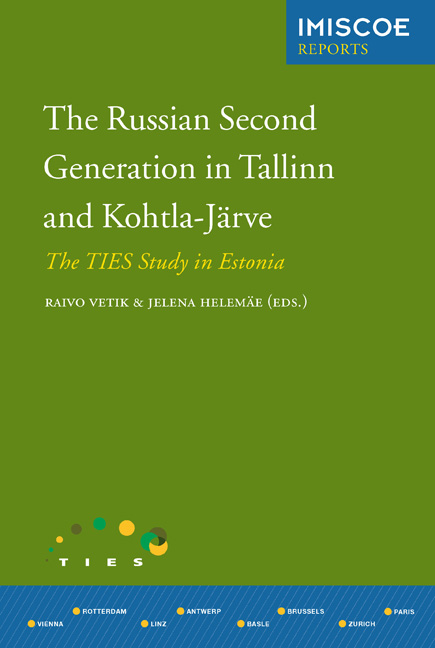Book contents
- Fronmatter
- Contents
- Preface
- List of Tables, Figures and Chapter Appendices
- 1 Introduction
- 2 Migration Patterns
- 3 Integration Policies
- 4 Ethnic Inequalities in Education
- 5 Explaining Different Returns from Human Capital in the labour Market
- 6 Income Inequality
- 7 Housing Conditions Andneighbourhood Satisfaction
- 8 Contact and Crisis in Interethnic Relations
- 9 Gender role Attitudes
- 10 Sense of Belonging to Estonia
- 11 Conclusions
- Appendix
- List of Contributors
- Other IMISCOE Titles
10 - Sense of Belonging to Estonia
Published online by Cambridge University Press: 20 January 2021
- Fronmatter
- Contents
- Preface
- List of Tables, Figures and Chapter Appendices
- 1 Introduction
- 2 Migration Patterns
- 3 Integration Policies
- 4 Ethnic Inequalities in Education
- 5 Explaining Different Returns from Human Capital in the labour Market
- 6 Income Inequality
- 7 Housing Conditions Andneighbourhood Satisfaction
- 8 Contact and Crisis in Interethnic Relations
- 9 Gender role Attitudes
- 10 Sense of Belonging to Estonia
- 11 Conclusions
- Appendix
- List of Contributors
- Other IMISCOE Titles
Summary
Introduction
This chapter will address one aspect of identificational integration by exploring the formation of a sense of belonging to the host country and its society among second-generation Russians in Estonia, based on the connection and emotional attachment to the host country and feelings of being part of the society. The innovation of the chapter is in providing an additional operationalisation of identificational integration, which differs from traditional approaches applied in empirical studies.
The studies of identificational integration of immigrants and their descendants based either on the linear or segmented assimilation theory or on their elaborations, have mostly focused on ethnic self-identification and the processes by which it is retained or rejected (Gans 1979; Alba 1990; Waters 1990; Esser 2004; Heckamm & Schnapper 2003; Portes & Rumbaut 1996, 2001). In the European context, for some immigrant groups, the religious identity, instead of ethnicity or together with it, is seen as one of the major indicators of identificational integration (Buijs & Rath 2006; Foner & Alba 2008). Another aspect often included in these studies is national identity formation, where the identificational integration is assumed to lead to the creation of a shared national identity, which requires certain commonalities, such as a shared language and core cultural values (Heckmann 2003). Besides looking at ethnic and national identifications, one can notice the rising interest in local collective identities, mainly at the level of residence city, as a possible source for the feeling of belongingness among the second generation (Kasinitz, Mollenkopf & Waters 2002; Groenewold 2008; Schneider & Stojčić 2008).
The most common definition of identificational integration in recent studies departs from the one proposed by Heckmann and his colleagues (Heckmann & Schnapper 2003: 10; Bosswick & Heckmann 2006: 10). They understand identificational integration as membership in a host society at a subjective level, indicated by the formation of feelings of belonging to and identifying with different groups in society, particularly ethnic, regional, local and national groups. Operationalisation of the identificational integration remains, in most cases, at the level of categorical identity measurement, giving information about self-categorisation into different groups in society.
- Type
- Chapter
- Information
- The Russian Second Generation in Tallinn and Kohtla-JärveThe TIES Study in Estonia, pp. 203 - 228Publisher: Amsterdam University PressPrint publication year: 2012
- 1
- Cited by



